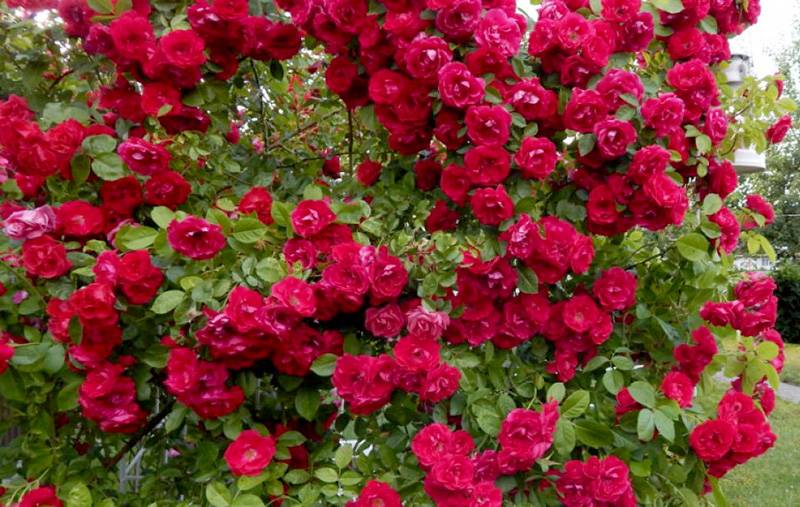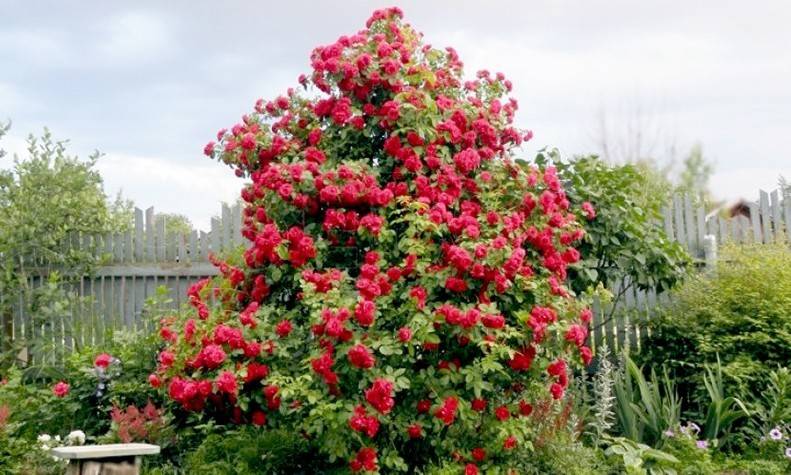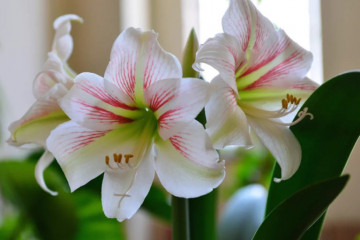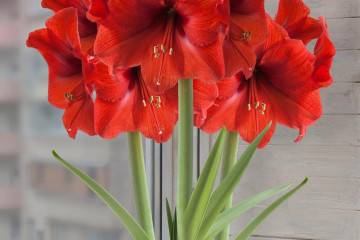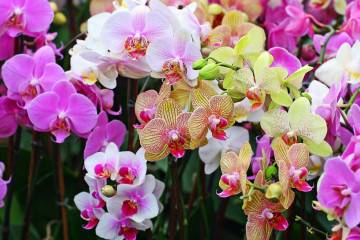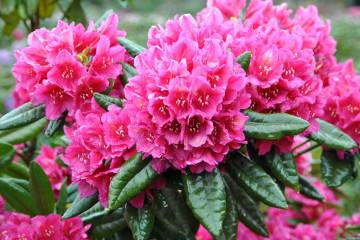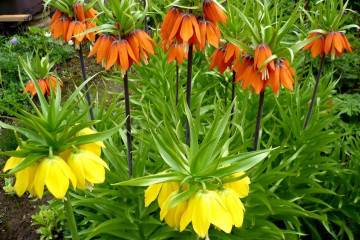Rose Flammentanz - planting and care, how to prune after flowering
Content:
For more than half a century, this variety has not lost its popularity with flower growers from different continents, constantly expanding the circle of its fans. The plant is appreciated for its beauty, unpretentiousness, abundant flowering.
Rosa Flammentants (Flammentanz, Flame Dance, Flaming Dance, KORflata, Vlammenspe) - what is this variety, history of creation
Flamentanz is a climbing rose (hybrid of the eglanteria rose and the kordesii rose), bred by the famous German breeder Wilhelm Cordes in 1955.
The name of the rose - Flammentanz (translated from German - the dance of fire) accurately conveys its appearance: during flowering, the bushes glow with red flowers, from under which the leaves are almost invisible.
Brief description, characteristic
The rose of the Flammentants variety conquers with bright, deep red flowers, collected in inflorescences from 3 to 10 on one brush. Double flowers with a diameter of 8-10 cm, consisting of 25-40 petals, exude a light, subtle delicate aroma. Numerous glossy leaves of juicy green color create a worthy background for the fiery flowers.
Bushes of hard shoots with large thorns can reach up to 2 meters in diameter and up to 2-4 meters in height.
Advantages and disadvantages of the variety
When choosing roses for their garden, flower growers pay attention to awards that guarantee the reliability and health of the variety. Flammentantz holds the prestigious ADR certificate - a symbol of German quality, which is awarded only to roses that have successfully passed many years of rigorous tests. The main advantages of varieties with the ADR mark:
- frost resistance - withstands frosts down to -30 degrees, distribution area - 4-8 zones;
- disease resistance even in unfavorable weather;
- lush bloom.
The only drawback of this variety is that it blooms once.
Use in landscape design
The climbing rose Flammentants is a wonderful decoration for any corner of the garden. It is planted near a fence, gazebo, mesh fencing, tall trees, used in pergolas, arches, distributing branches on supports along which they will curl.
Growing a flower
When buying a Flammentant rose, it is imperative to inspect the seedling. Only a healthy plant should be purchased from trusted manufacturers.
Grafted and self-rooted rose seedlings are on sale. For the Flammentants variety, there is no particular difference: in any case, it has a strong root system.
What time is the boarding
Spring and autumn are a good time to purchase a Flamentanz rose, when you can plant without worrying about a bad winter:
- spring planting is preferable: the plant has time to gain strength. It is necessary to plant in early to mid-May, when the threat of frost has passed and the earth warms up;
- favorable time for autumn planting is September. The rose must have time to take root in order to survive the winter period without problems.
Location selection
In order for the Flammentanz rose to develop normally and delight with lush flowering, you need to choose a sunny, unheated area with good air circulation, but without drafts, with deep groundwater.
How to prepare the soil and flower for planting
The chosen place for planting the Flammentant rose must be prepared in advance: dig up, remove the roots of the weeds. If you plan to plant several bushes, then the distance between them should be at least 1.5 meters. The size of the landing pit is 50x50 centimeters.
For a rose, sandy loam soil with neutral acidity is preferable.
The sequence of filling the well:
- Broken brick or river pebbles are laid at the bottom with a layer of 20 centimeters.
- The same layer of prepared soil is added, consisting of cow dung, compost, humus, peat and sand.
- Everything is thoroughly watered with water.
It is advisable to prepare the seedling a day before planting:
- Examine shoots and roots carefully.
- Remove damaged areas, process the cuts with garden pitch or charcoal.
- Immerse the roots in a container of water so that the root system is saturated with moisture and absorbs nutrients better.
Planting procedure step by step
The seedlings are neatly placed in the middle of the hole, maintaining the planting depth:
- for grafted roses - the graft should be 2.5 cm below ground level;
- for own-rooted ones - the root collar should be recessed by 3-4 cm.
It is better to fall asleep with earth gradually, in several steps, each time watering, so that no voids remain between the roots. The top layer around the seedling can be sprinkled with sawdust or mulch to retain moisture.
Plant care
Climbing rose Flammentants is one of the most unpretentious queens of flowers that does not require special care. It is necessary to remove weeds, regularly inspect the bush and take appropriate measures if necessary.
Watering rules and humidity
The plant should be watered only during prolonged drought, no more than 1 time per week. This should be done early in the morning or in the evening, using warm, settled water - 1 bucket per bush.
Top dressing and soil quality
For top dressing, it is preferable to use organic fertilizers. You can use manure diluted in water, but it is best to feed it with green fertilizer - an infusion of herbs collected during weeding, in which there is a storehouse of microelements.
If the soil under the bush is mulched or ground cover plants are planted, then there is no need to loosen the soil. If the land is open, then loosening is required, which is desirable to carry out every time after watering.
Pruning and replanting
Flammentants roses are pruned twice a year:
- in spring, after removing the shelter, damaged branches are removed;
- the purpose of summer pruning is the formation, rejuvenation, thinning of the bush, removal of old (more than 3 years) and damaged branches.
With proper pruning, abundant flowering is guaranteed next year.
It is more favorable to transplant a Flammentant rose to a new place in the evening:
- Remove carefully from the supports.
- Dig in the bush in a circle at a distance of 50 cm from the center.
- Carefully remove from the ground.
- Plant in a prepared hole.
- Add soil and water in several steps.
- After 3 days, fill up, if necessary, the earth, huddle, mulch or plant ground cover perennials.
Features of wintering a flower
Flammentant is one of the most frost-resistant varieties of roses. Since the buds are formed on the shoots of the last year, you need to keep the young shoots from freezing. To do this, with the onset of cold weather, the branches are removed from the support, collected in bunches and gradually gently bent to the ground, covered with a "pillow" of collected dry fallen leaves or spruce branches. Top covered with leaves or covered with spruce branches.
Blooming rose
Rosa Flammentants blooms only once a year for 30-40 days, and only on last year's shoots.
A period of activity and rest
With the onset of spring, the active growth of the plant begins, the laying and emergence of buds. The flowering period begins in late May and early June. After its end, branches continue to grow and new shoots appear. From mid-autumn, the rose gradually moves into a period of winter dormancy.
Care during and after flowering
After removing the shelter and spring treatment of the plant, potash fertilizers must be applied to stimulate growth and flowering. For flowering to be long-lasting and beautiful, you need to remove faded flowers, withered leaves and dry shoots.
What to do if it does not bloom, possible reasons
The lack of flowering can cause several reasons:
- lack of nutrition due to heavy and infertile soil - it is advisable to transplant the bush into loose fertile soil;
- lack of nutrition for the formation of buds - feed with a special fertilizer for roses, bringing it under the bush and spraying the branches;
- low light - you need to transplant the rose to a sunny place;
- incorrect cropping.
Flower propagation
Cuttings and cuttings obtained from an existing bush take root well. It is advisable to carry out cuttings after flowering, reproduction by layering - in the spring, when the earth warms up.
Detailed description
For cuttings, branches are chosen with a thickness of at least 0.5 cm, a length of up to 20 cm, with 3-4 buds.
Sequence of grafting:
- The bottom cut should be done at a 45 degree angle as close to the kidney as possible, the top cut at a right angle and away from the kidney.
- The lower leaves are removed, the upper ones are cut in half.
- Cuttings should be placed in Kornevin solution for 15-20 minutes.
- Plant in a container filled with sandy soil, deepening by 2 cm.
- Cover with a plastic bottle and put in a bright place, shading from direct sunlight.
- After a month, transplant the cuttings into a flower pot with prepared fertile soil and leave to winter in a warm room.
- In the spring, when the threat of frost has passed, transplant it into open ground.
Actions for propagation by layering:
- Select shoots at the root collar of the bush.
- Prepare shallow grooves for them.
- Press the branches to the ground and place them in the grooves.
- Leave the upper part of the shoots outside.
- Make several annular cuts at the points of greatest contact with the ground.
- Sprinkle the layers with soil, loose and fertile.
Already in the fall, the layers will give roots, but it will be possible to separate and plant them only in the spring of next year.
Diseases, pests and ways to control them
The variety has a high immunity to diseases. He is not afraid of diseases such as black spot and powdery mildew.
Pests can appear in adverse weather conditions:
- aphids - during prolonged rains and excessive watering;
- spider mites - on the contrary, in hot and dry summers.
For pest control, spraying with appropriate insecticides must be carried out.
The bright and unpretentious Flammentantz rose, which withstands rain, heat, and frosty winters with dignity, is a wonderful decoration of the garden. Even a novice florist can grow it.
